#cuthbert collingwood
Text
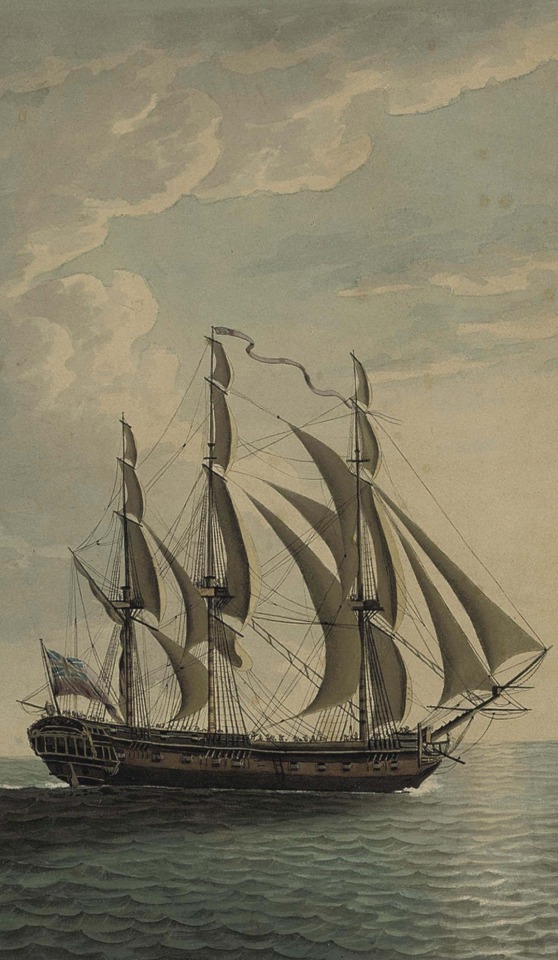
H.M.S. Mediator about to attack an enemy convoy off Cape Ortegal, 12th December 1782 (detail), circle of Robert Cleveley, late 18th century (Wikimedia Commons).
Jeffery Raigersfield, son of Baron de Raigersfield, joined HMS Mediator in 1783 as a 12-year-old captain's servant (midshipman) under Captain Cuthbert Collingwood. Raigersfield's nice kit attracted the wrong kind of attention:
He soon noticed that his large chest of clothes, ‘which included ten pounds that was in it, in halfpence and silver, cost my parents one hundred pounds’, began to attract the attention of his messmates whenever he went to unlock it. To begin with it was so full that ‘assistance was necessary to close the lid down before it could be locked up’, but it was not so long before he could close it without help, ‘for I began to lose my clothes, and no one knew anything about them’. [...]
He wrote sorrowfully that ‘as to the mess things that I brought on board in my chest, such as tea, sugar &c, they had been consumed long before for the common good, and my pewter washhand basin, the only visible remains of my more than ample fitting out, was only mine when others were not using it’.
— Dudley Pope, Life in Nelson’s Navy
#midshipman monday#age of sail#midshipmen#royal navy#naval history#dudley pope#life in nelson's navy#hms mediator#18th century#age of fighting sail#maritime history#naval art#robert cleveley#jeffrey raigersfield#cuthbert collingwood
100 notes
·
View notes
Text
She mourns (...) her faithful Pitt
This very ... patriotic, poem was published by The Gentleman’s Magazine in early 1806. It was written by the anonyms “B” to commemorate all the changes the end of 1805 and the begin of 1806 brought to the nation. While I find some of the stanzas a bit … questionable, some passengers sound rather nice.
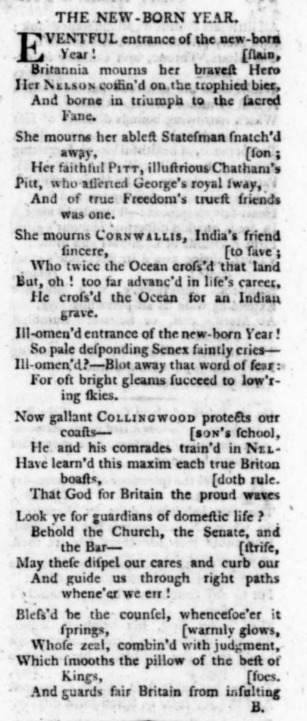
The New-Born Year
Eventful entrance of the new-born Year!
Britannia mourns her bravest Hero Slain,
Her NELSON coffin’d on the trophied bier,
And borne in triumph to the sacred Fane.
She mourns her ablest Statesman snatch’d away,
Her faithful PITT, illustrious Chatham’s Son;
Pitt, who asserted George’s royal sway,
And of true Freedom’s truest friends was one.
She mourns CORNWALLIS, India’s friend sincere,
Who twice the Ocean cross’d that land to save;
But, oh! Too far advanc’d in life’s career.
He cross’d the Ocean for an Indian grave.
Ill-omen’d entrance of the new-born Year!
So pale desponding Senex faintly cries-
Ill-omen’d? – Blot away that word of fear:
For the bright gleams succeed to low’ring skies.
Now gallant COLLINGWOOD protects our coast-
He and his comrads train’ in NELSON’s school,
Have learn’d this maxim each true Briton boasts
That God for Britain the proud waves doth rule.
Look ye for guardians of domestic life?
Behold the Church, the Senate, and Bar-
May these dispel our cares and curb our strife,
And guide us through right paths whene’er we err!
Bless’d be the counsel, whencefoer’er it springs,
Whose zeal, combin’d with judgment, warmly glows,
Which smooths the pillow of the best of Kings,
And guards fair Britain from insulting foes.
B.
The Gentleman's Magazine, 1806, 2:76, p. 255.
#horatio nelson#william pitt#william pitt the younger#charles cornwallis#cuthbert collingwood#1805#1806#british history#history#the gentelman's magazine
6 notes
·
View notes
Text
Guest post by Jenny Newbold ‘The ship was not the only "she" at sea’
Guest post by Jenny Newbold ‘The ship was not the only “she” at sea’
I am thrilled to welcome a new guest to All Things Georgian, Jenny Newbold who has recently published a fictional book, ‘The Private Misadventures of Nell Nobody’ which was published in June 2022 by Luminare Press. It is an historical-fiction/adventure novel featuring Admiral Lord Nelson and a gender-ambiguous protagonist, examining from ‘Ned’s’ perspective the events of Horatio Nelson’s first…

View On WordPress
#18th century women at sea#Georgian Royal Navy#Jennifer Newbold#John Jervis Earl of St Vincent.#Vice Admiral Cuthbert Collingwood
0 notes
Text
The Battle of Trafalgar - a brief timeline
At 6am on 21 October 1805, the two fleets sighted each other and at 6.40am Nelson gave the order to ‘prepare for battle’. The French were sailing in line off Cape Trafalgar, while the British came in from the west, gradually forming two lines. The British fleet was outnumbered, the enemy totalling nearly 30,000 men and 2632 guns to Nelson’s 18,000 men and 2148 guns.

Plan of Lord Horatio Nelson's attack strategy (1758-1805), on the combined fleet (France and Spain), October 21, 1805 (Battle of Trafalgar). Lithograph (27 x 36.7 cm), published by Robert Dodd, 1805, England
At 11.45am Nelson ordered a special signal to be flown from his flagship Victory. It read: ‘England expects that every man will do his duty’. The signal was greeted with delight by the fleet.
Finally, at 11.50am, French commander Pierre-Charles-Jean-Baptiste-Silvestre de Villeneuve sent the signal ‘engage the enemy’. The French vessel Fougueux fired the first shots at Vice-Admiral Cuthbert Collingwood’s flagship, Royal Sovereign. The battle had begun. Collingwood was the first to reach the enemy line, firing a broadside into one of the Spanish flagships, Santa Anna. The ships in his division followed him, approaching in a slanting line, spreading the force of the impact and enveloping the allied rear as Nelson had intended.
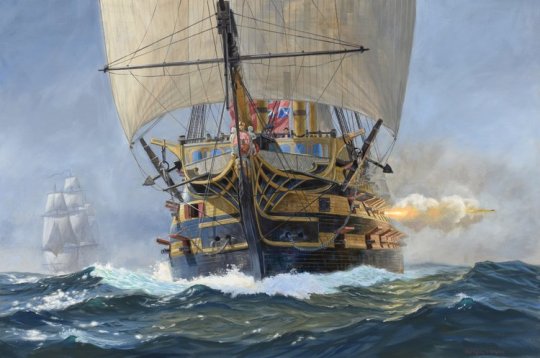
HMS Victory, by Patrick O'Brien (1960-)
Nelson meanwhile headed towards the great Spanish ship, Santissima Trinidad, but spotting that Villeneuve was flying his flag on the Bucentaure, the next ship astern, he ordered Flag Captain Thomas Hardy to attack her first. The Victory passed under the stern, firing a broadside as she went, giving the Bucentaure a knockout blow.
As the Victory moved on she became entangled in the Redoutable, and the two ships drifted away. This created a large gap in the Franco-Spanish line through which Nelson’s division then poured, splitting the enemy fleet in two – again, exactly as Nelson intended.

Breaking the Line, by Patrick O'Brien (1960-)
The battle developed into a ferocious pounding match but the British had the advantage thanks to Nelson’s strategic pre-planning and the fact his men were better trained in delivering rapid, accurate gunnery. When firing finally ceased at 5.30pm, 17 enemy ships had been captured and another was a blazing wreck. Four managed to escape but were captured a few weeks later, and 11 managed to struggle back to Cadiz.
A total of 449 British sailors were killed and 1217 wounded. French and Spanish losses were heavier: 4408 were dead, 2545 wounded and some 20,000 taken prisoner.
Britain’s decisive victory was overshadowed by news of the death of Nelson, who was shot onboard Victory at 1.15pm and died at 4.30pm. The triumph was further eclipsed by a fierce storm that raged after the battle, forcing the British to abandon most of their captured enemy ships.

The Battle of Trafalgar, 21 Ocotober 1805, by unknown
News of Trafalgar reached London a fortnight later in the early hours of 6 November 1805. Public rejoicing for the victory was muted by widespread sorrow for the death of Nelson. As a reward for Trafalgar, Collingwood was made a baron, all the captains received the official Naval Gold Medal and a special grant of money was made by the government to all those who had taken part. This was to compensate them for the prize money they lost when their captured vessels sank in the storm.
The Battle of Trafalgar cemented Britain’s reputation as ruler of the seas and demonstrated that the Royal Navy had superiority in training, professionalism and expertise in naval tactics that set it apart from its rivals. By 1809 there were over 140,000 men serving on 732 ships, more than ever before.
However, the victory at Trafalgar had little overall impact on the course of the war. Napoleon needed more to be stopped.
#naval history#battle of trafalgar#21 october 1805#trafalgar day#brief timeline#19th century#age of sail
75 notes
·
View notes
Text
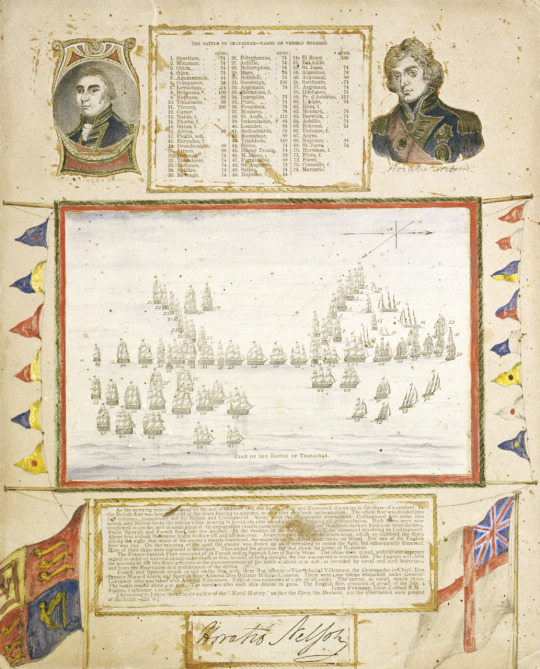
In The Life and Letters of Captain Frederick Marryat, Florence Marryat included some unpublished and incomplete manuscripts from her father's papers. Among them was "The Victory", about the Battle of Trafalgar, a poem described by Florence as a "sea song." Here are the first two stanzas:
Stop the fiddle! cease your reeling!
All now gather close to me.
Silence, girls, while I’m revealing
How we gained the victory.
Off Trafalgar’s Cape, long seeking,
Nelson’s flag was at the fore;
In close order, two lines keeping,
Down upon the foe we bore.
II.
In a crescent wide extended,
They received us to engage;
Soon the morning’s brightness ended —
All obscured by battle’s rage.
Up the bunting runs again, boys;
Break the stops, the flags blow clear!
When the signal was explained, boys,
Then, indeed, there was a cheer!
'Plan of the Battle of Trafalgar': print with Cuthbert Collingwood and Horatio Nelson in insets.
#frederick marryat#captain marryat#age of sail#battle of trafalgar#trafalgar#the victory#life and letters#i think marryat wasn't bad as a poetry/song writer#but i'm sparing you the part where he rhymes 'booty' and 'duty'
18 notes
·
View notes
Text
Horatio Nelson, 1st Viscount Nelson, KB (1758 - 1805) Vice-Admiral of the White
Cuthbert Collingwood and Horatio Nelson: British School, National Maritime Museum (19th century)
Trafalgar Square, London
Related ancestral blog article:
Lords High Admiral of the United Kingdom
Horatio Nelson, 1st Viscount Nelson, KB, Vice-Admiral of the WhiteBirth 29 Sep 1758 in Burnham Thorpe, Norfolk, EnglandDeath 21 Oct 1805 in Battle of Trafalgar, Cape Trafalgar, Spain
agnatic…

View On WordPress
0 notes
Text

The Battle of Trafalgar, 21 October 1805 [1] c. 1905-08
One of a series of five paintings depicting the events of the Battle of Trafalgar. Following Nelson's orders, the 'Royal Sovereign' led by Collingwood was to enter the battle at right angles, rather than broadside in an attempt to swiftly 'decapitate' the enemy's navy. This was an unusual and risky tactic. Here, the 'Royal Sovereign' breaks the enemy's line and passes the stern of the Spanish flagship, 'Santa Anna'. On the left in the foreground is the Spanish two-decker 'San Justo' and on the right a column of English battleships ready to enter the engagement.
The group was possibly painted c. 1905, around the time of the battle's centenary, and it is unusual in de Martino's oeuvre, as these are the only historical scenes by him. De Martino's contemporaries, Thomas Jacques Somerscales and William Wyllie had both portrayed the event in the 1890s (Somerscales painting c. 1894, in the Government Art Collection). However, it was perhaps an appropriate reminder of one the greatest naval victories at a time when there was rising unease at the threat of war with Germany, and plans to build a Home Fleet.
In 1910 the paintings remained unsold and de Martino sent a round robin letter stating his wish that the Nation should have his 'life of Nelson paintings'. A response was sent on behalf of the King saying he would like to help, but couldn't quite see a way to realise this. On October 30th 1912, following de Martino's death, George V's Private Secretary, Lord Stamfordham reported that he had visited the artist's widow at her late husband's studio presumably to view the paintings. Isabel de Martino insisted that the paintings were only to be sold all together. On the 6 February 1913 she wrote to Lord Stamfordham…' I am pleased to accept your offer, about my husband's pictures. From the first, I told you how happy I was to feel that the King would have the Trafalgar pictures… I accept the offer of Twelve thousand guineas for the 7 pictures, the series of the 5 pictures of the battle of Trafalgar and, 1 of the Nile; 1 of the battle of St Vincent.'
George V's diary records that on Sunday 9 March, 1913: 'In the afternoon we went with David & Mary to Martino's studio and his widow and daughter showed us all his pictures.'
Purchased by King George V from the artist’s widow, February 1913
#eduardo de martino#art#painting#history#england#france#spain#lord nelson#horatio nelson#lord collingwood#britain#cuthbert collingwood#pierre villeneuve#federico gravina#the battle of trafalgar#royal navy#naval battle#naval warfare#age of sail#battleship#napoleonic wars#royal sovereign#broadside#santa anna#san justo#engagement#british#britannia#flagship#george v
26 notes
·
View notes
Photo

Collingwood trying to persuade his daughters that math is fun.
7 notes
·
View notes
Photo

Cuthbert Collingwood, Baron Collingwood, 1823, Charles Turner
2 notes
·
View notes
Photo
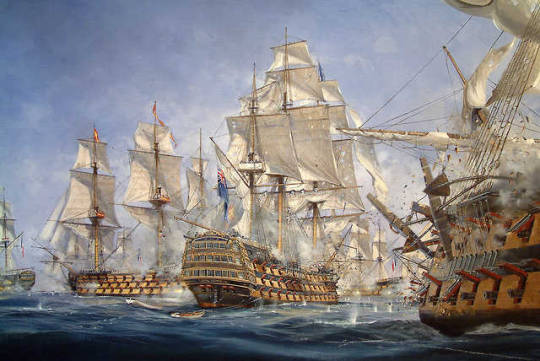
The 100-gun first rate ship of the line HMS Royal Sovereign coming between the 74-gun French ship Fougueux and the 112-gun Spanish ship Santa Ana during the first engagement in the Battle of Trafalgar. HMS Royal Sovereign was the lead ship of the southern column of the British fleet under Vice Admiral Cuthbert Collingwood.
By Richard Grenville
#trafalgar#battle of trafalgar#royal navy#history#military history#navy#tall ship#tall ships#19th century#napoleonic#Napoleonic wars#age of sail
371 notes
·
View notes
Photo

The 74-gun third rate ship of the line HMS Belleisle completely dismasted after the Battle of Trafalgar, 21 October 1805. The ship in the background is most likely the 100-gun first rate ship of the line HMS Royal Sovereign.
HMS Belleisle was launched on 29 April 1794 as the French Marat, later renamed as Formidable, before she was captured and taken into service by the British Royal Navy in 1795.
At the Battle of Trafalgar, she was the second ship of the British southern Column under admiral Cuthbert Collingwood onboard the HMS Royal Sovereign, the first ship and flagship of the column.
Painting by William Lionel Wyllie
1 note
·
View note
Text
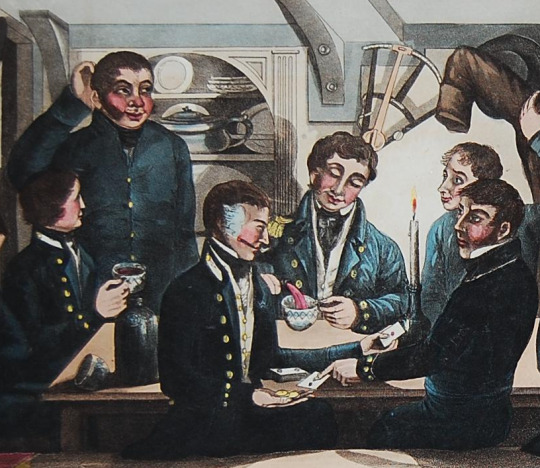
Detail from 'The Interior of a Midshipman's birth', 1821 print by George Humphry after Captain Frederick Marryat (British Museum).
The midshipmen ate in their own berth. Depending on the makeup of the group (age-range, family background, etc), conditions varied from civilised to the squalid. Where there was a responsible older midshipman he would be the most obvious mess caterer. The very young 'young gentlemen' (also known as 'squeakers') were put under the charge of the gunner, although the captain usually took responsibility for their money and expenses, doling out pocket-money as appropriate and writing to their fathers for more when necessary. Admiral Cuthbert Collingwood wrote to his friend Walter Spencer-Stanhope of his son, William, 'Your son's debts are not enormous yet—you cannot think how cheap salt water is, and there is nothing else to buy'. No-one seems to have reported what happened with older midshipmen, at the age between squeaking and financial responsibility; perhaps the captain delegated the task of mess caterer for these boys to one of the other officers.
— Janet Macdonald, Feeding Nelson’s Navy: The True Story of Food at Sea in the Georgian Era
Numerous sources speak of young midshipmen being in the care of the ship's gunner, for example Brian Lavery's book Nelson's Navy: The Ships, Men and Organisation, 1793 - 1815:
Traditionally these 'youngsters' were placed in the care of the gunner, and lived in the gunroom on a ship-of-the-line. 'In the Irresistible I again messed with the gunner, Mr Gallant, who took great care of me.' [Captain Boteler's Recollections] In 1805 the gunner was moved out of the gunroom, but it seems that the 'young gentleman' stayed there. On frigates, they probably berthed among the older midshipmen.
It seems paradoxical that the man responsible for the use and maintenance of deadly artillery was also expected to help care for young children, but he was. In his semi-autobiographical novels, Frederick Marryat's midshipmen can always be found in the gunroom, although they are mentored by various officers and older midshipmen.

'Mr B Mast-headed': an 1820 graphite and watercolour drawing of a mastheaded midshipman by Frederick Marryat (British Museum).
#age of sail#midshipman monday#royal navy#naval history#midshipmen#military history#frederick marryat#maritime history#feeding nelson's navy#janet macdonald#gunner#warrant officers
44 notes
·
View notes
Photo

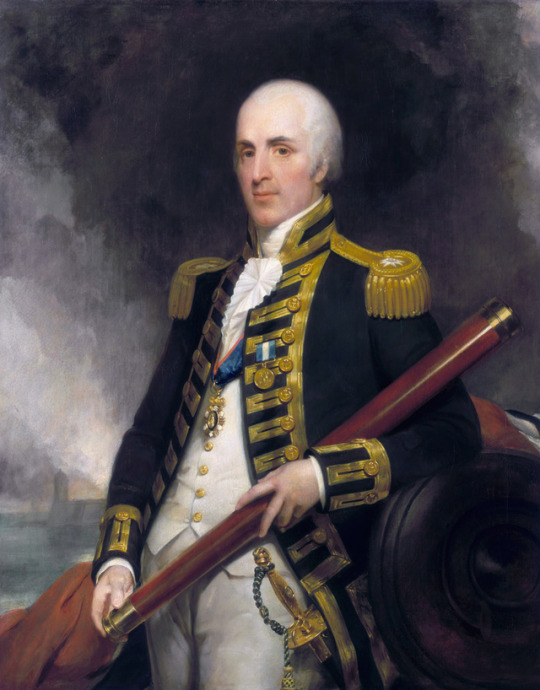


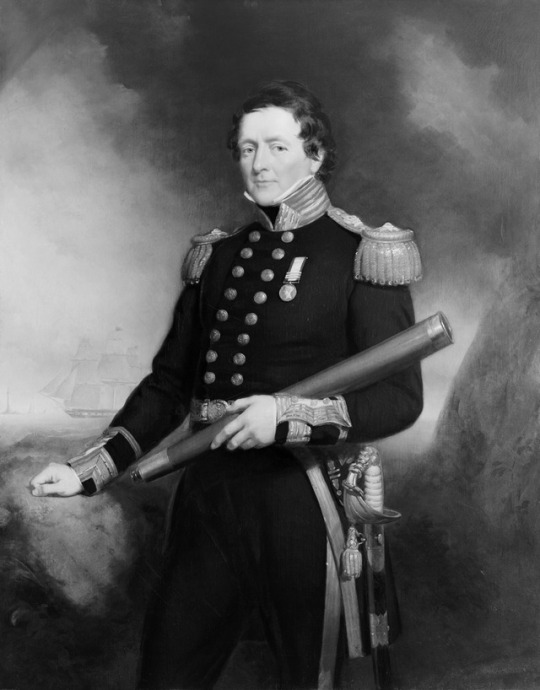

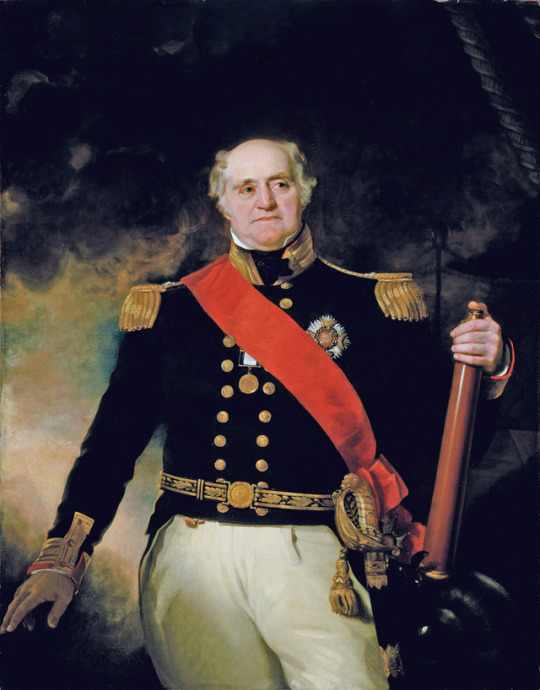
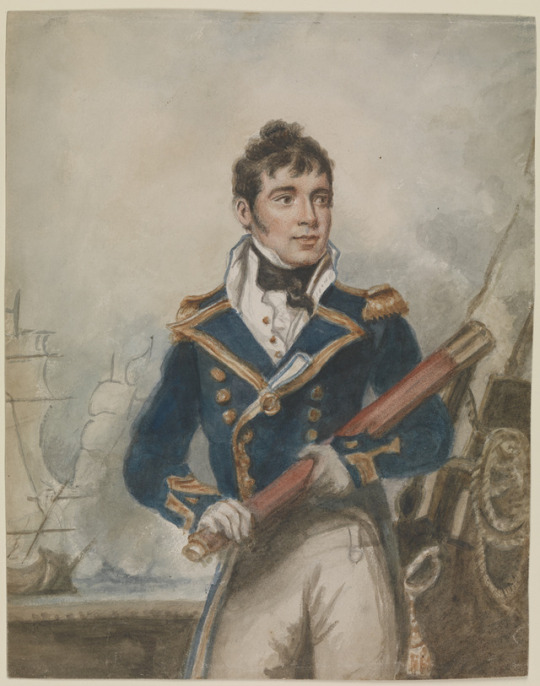
Naval Portraits—Obnoxious Telescope Edition
Captain William Parry, c. 1830
Rear Admiral Alexander Ball, c. 1805
Vice Admiral Cuthbert Collingwood, c. 1840
Captain John Walter Roberts, c. 1823
Admiral Sir Owen Watkin Pell, c. 1849
Rear Admiral Sir Edward Brace, 1837
Vice Admiral Sir Thomas Masterman Hardy, 1834
Captain Sir William Hoste, c. 1800
127 notes
·
View notes
Photo

So this is intriguing....
Dr. Carl McIntire
The Christian Beacon
Haddon Avenue and Cuthbert Boulevard
Collingwood, New Jersey, 08108
I thought you would be interested in seeing an exchange of correspondence regarding Billy’s accepting a degree from a Catholic school.
The reply from Dr. Bell, Billy’s father-in-law, shows beyond a shadow of a doubt what an opportunity Graham is and how completely without scruples. I have always thought Dr. Bell was a plain fool, and this letter certainly proves it. Only an idiot would have written it. I hope we can give it as much publicity as possible.
Hurriedly and cordially,
Bob, President
1 note
·
View note
Text

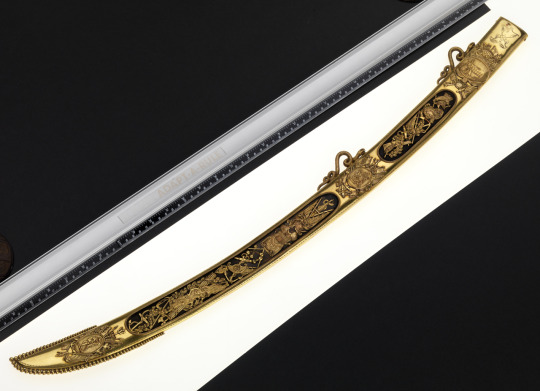
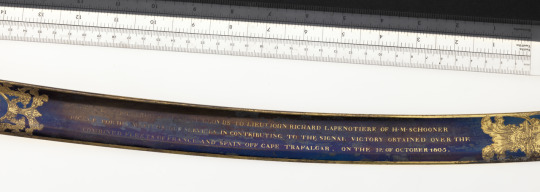

Lloyds Patriotic Fund £100 Trafalgar pattern presentation sword that belonged to Captain J.R. Lapenotiere (1770-1834)
John Richard Lapenotiere entered the Navy in 1780. He served in the South Seas with King George's Sound Company between 1785-1788. He re-entered the Navy when war broke out in 1793. In 'Boyne' under Sir John Jervis at the reduction of the French West India Islands. He was promoted to the rank of Lieutenant in 1794. He commanded the hired cutter 'Joseph' in the Mediterranean between 1800-1803. Whilst in command of the schooner 'Pickle' he rescued the crew of the 'Magnificent', which was wrecked off Brest in 1804.
He commanded the 'Pickle' at the Battle of Trafalgar and was sent home by Vice-Admiral Cuthbert Collingwood (1750-1810) with the dispatches announcing the victory at Trafalgar and the news of Vice-Admiral Horatio Nelson's (1758-1805) death. For this service Lapenotiere was promoted to the rank of Commander and awarded a Lloyd's Patriotic Fund Sword.
He commanded the 'Orontes' at the bombardment of Copenhagen in 1807 and was promoted to the rank of Captain in 1811. He died in Cornwall in 1834.
#naval artifacts#naval weapons#patriotic sword#captain lapenotiere#late 18th -early 19th century#age of sail
88 notes
·
View notes
Text
The 5 Best Places To Retire In Canada

When you reach a certain age, you realize that your life has changed a lot. You may have bought your family house 10 years ago, 20 years ago, or even 30 years ago. Your kids may have moved out now, and have lives of their own. Prices have changed, music has changed, fashion has changed, everything has changed. And this may be the reason why, since you’re already getting older, you may also want to change your environment.
And now that you’ve decided you want a change in scenery, it’s time to decide where! You may have already spent some time looking at real estate prices, crime rates, climate data, or statistics and figures. Those numbers may help you decide, but let’s be honest: these figures never really give you the whole picture.
So, what should you do? Well, here at Greater Property Group, we’ve scoured the country, and found the absolute best places to retire in Canada.

1. Ottawa, Ontario
The city of Ottawa is known as the heart of Canada’s capital region, Ontario. Ottawa has a population of 934,243, and has a vibrant lifestyle. Every year, since 1952, the city celebrates the Canadian Tulip Festival.
For obvious reasons, the city of Ottawa is a fantastic retirees’ destination. Ottawa is one of the best places to settle in, and offers a great mix of attractions and conveniences. The two rivers that flow through Ottawa are lined with greenspace and parkland. There are plenty of galleries and museums for you to enjoy. You can go to the National Gallery of Canada, Canadian Museum of History, Canada Science and Technology Museum, Canada Aviation and Space Museum, and Canada Agriculture and Food Museum.
Financial-wise, in 2016, the city was ranked top 1 by MoneySense in their list of the Best Places To Live. The next year, the city ranked top 2. Ottawa is especially noted for their great access to health care, a collection of cultural activities, and their active real estate market.
If you don’t want to live in the city, you can also live in the smaller communities nearby. These communities are definitely worth considering, and some of them even offer great real estate values. There are plenty of houses here that are modern, with a touch of small town charm. You can visit Manotick, Stittsville, and Carleton Place, if you want to be near the capital, yet still be able to enjoy country living.

2. West Vancouver, British Columbia
The city of West Vancouver is a city where you can enjoy the temperate coastal temperature, while sipping your cocktail in a coconut shell. West Vancouver’s lifestyle is casual, with a population of 42,473. If you enjoy reading, you’ll be happy to know that the city has the highest number of books lent each year in the entire country!
The city of West Vancouver is one of the best cities to retire in for plenty of reasons. West Vancouver is home to Cypress Provincial, which is the signature attraction of the city. The park is filled with cross-country skiing and hiking trails that everyone can enjoy. It’s no wonder that the country is also chosen as the host of most Winter Olympics events.
Yes, all of the cities in British Columbia are great for retirement - however, West Vancouver is the cherry on top. The city is set comfortable away from the busy streets of Vancouver, and has inexpensive real estate. And if you find yourself missing the city lights, all you need to do is cross the Lion’s Gate Bridge!
In the city of West Vancouver, you’ll get to enjoy the mountain scenery and explore the parks, such as Cypress Provincial Park and Stanley Park. Plus, according to the law, industries are not allowed within the city. Wouldn’t it be great to spend your days being active and having fun here?

3. Collingwood, Ontario
The town of Collingwood first became a town in 1858, and has a population of no less than 21,000. Collingwood was named after the second-in-command of Lord Nelson during the Battle of Trafalgar, Admiral Cuthbert Collingwood. The lifestyle here is very social, and the weather is continental. You will also find the largest Elvis festival in the world, the Collingwood Elvis Festival, right here. It’s been held in July every year since 1994.
No matter who you ask about their favourite summer beach destinations in Canada, you’ll surely hear Collingwood as part of their list. And it’s no wonder why, since the town has remarkable features such as Georgian Bay, and Sunset Point Beach. If you’re a sun-worshipper, then you’ll surely enjoy living in Collingwood.
Georgian Bay is home to some of Canada’s most beautiful waters to sail in. In this town, you’ll find Balmoral Village, the community with an adult lifestyle. During the winter, the town also boasts skiing areas, which you can find in the nearby Blue Mountain. Plus, the town’s entire surrounding area is filled with unparalleled natural beauty.

4. Calgary, Alberta
The city of Calgary is known as the sunniest city in Canada. Well, it’s not overrated in any way, since the city’s warm wind, the chinook, can become 15 degrees centigrade in just a few hours! The city has, of course, a continental weather, while the lifestyle is cosmopolitan. Calgary has a population of 1,239,220, and plays host to the largest outdoor event in the world: Calgary Stampede.
The Economist named the city of Calgary as one of the world’s most livable cities. Calgary has the highest GDP in Canada each year. It also provides its residents with the best quality of life. These qualities all serve to make the city the Wild Rose Country’s prized jewel.
The city of Calgary certainly has the feel of a big city, while also retaining the classic small town charm. Here, you can easily enjoy the nightlife, street festivals, and other outdoor activities. Calgary features a lifestyle where you can enjoy working hard (which you have surely done for decades), while playing harder.

5. Clarington, Ontario
You can find the municipality of Clarington just outside the Greater Toronto Area, and on Lake Ontario’s pristine shores. This municipality offers one of the most wonderful communities you can find in all of Canada. Here, you can enjoy the life of living in the city, while within reach of escaping to relax in the country. Even as a retiree, Clarington will let you have a place to work, do your business, be able to play, or simply stay active.
The community of Clarington has humid continental weather, and has a population of 92,013. Here, you’ll be able to enjoy a slow lifestyle, or a fast-paced day-to-day living, the choice is all yours. You’ll be able to walk the parks, hike the trails, or swim on the beaches! Not to mention, the home of summer concerts, Canadian Tire Motorsport Park, can also be found here.
Clarington is within reach of Toronto, making it desirable in many ways. The prices of real estate are reasonable. However, you have to be quick, since the market is quickly and steadily appreciating. It’s no wonder, since Clarington has a strong presence of commuting families, while also boasting a low crime rate.
Living The Life!
Who said that because you’re getting older, you have to live less? Well, whoever said that got it all wrong. As a retiree, you have all the time in your hands, so why not make the best of it? Choose the best place that you should have. Pick your new home, pack up your stuff, and make your move now. Soon you’ll be there, saying, “I’m here… and I’m living the life!”
#canadahouse, #realestateproperty, #propertyforsaleincanada, #canadahouseforsale, #canadahouseforrent, #canadahouseprice, #canadahouseandhome, #rentahousecanada, #canadahousecost, #canadahousedebt, #houseforsalecanada, #cheaphousesforsaleincanada, #homesforsaleincanada, #canadaapartmentforsale, #propertyforsaletoronto, #tinyforsalecanada, #luxuryhomesforsaletoronto, #canadapropertyprices, #historichousesincanada, #iconichousesincanada, #mostexpensivehousesincanada, #cheappropertiesforsaleincanada
https://www.greaterpropertygroup.com/gpg-blog/The-5-Best-Places-To-Retire-In-Canada
https://www.greaterpropertygroup.com/
#Canada house#real estate property#property for sale in Canada#property for sale Toronto#Canada house for sale#Canada house for rent#Canada house price#rent a house Canada#Canada house cost#Canada house debt#house for sale Canada#tiny house for sale Canada#Canada apartment for sale#Canada property prices#historic houses in Canada#iconic houses in Canada#most expensive houses in Canada#cheap properties for sale in Canada
0 notes